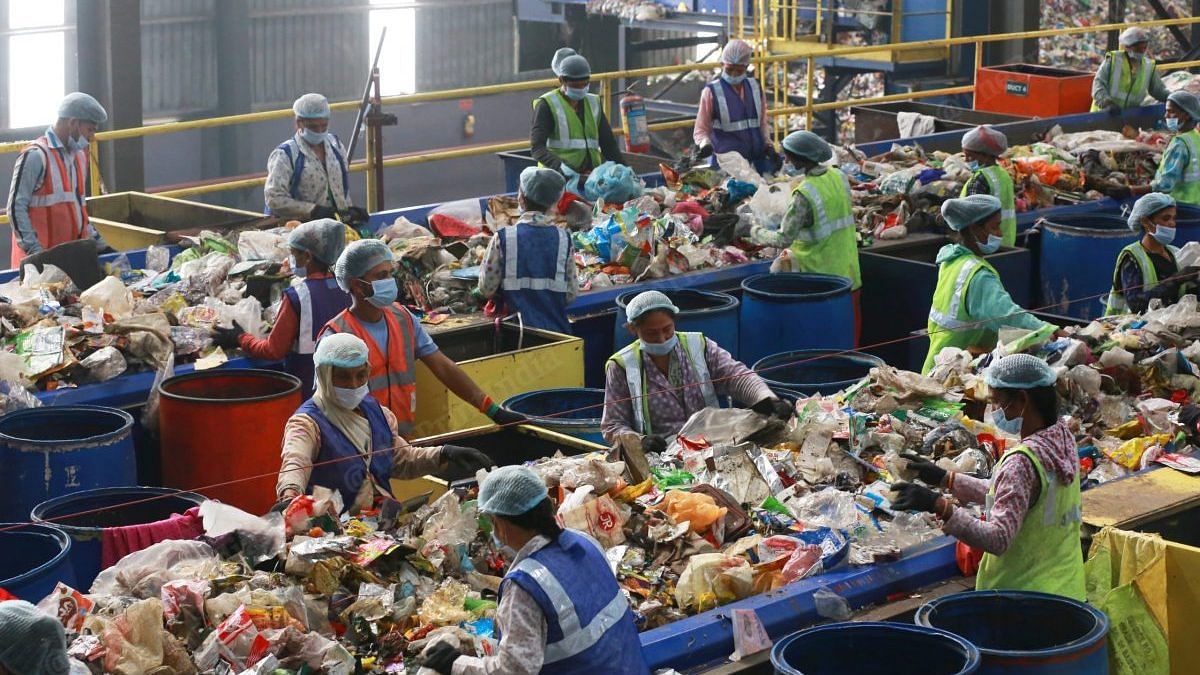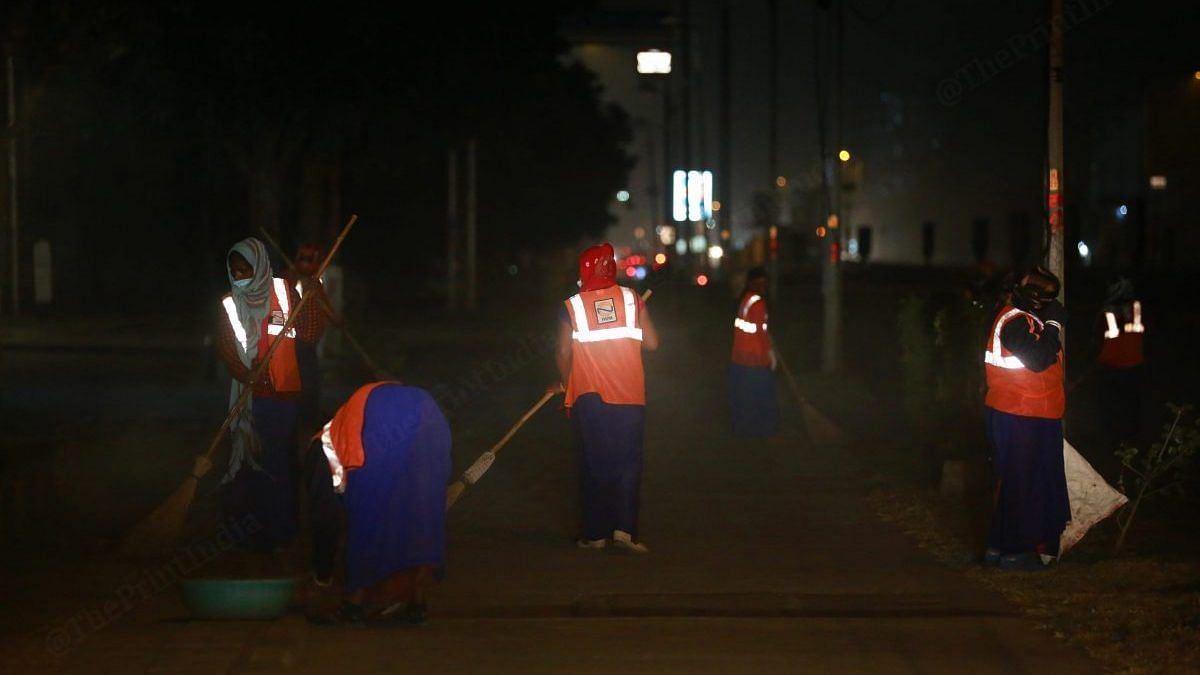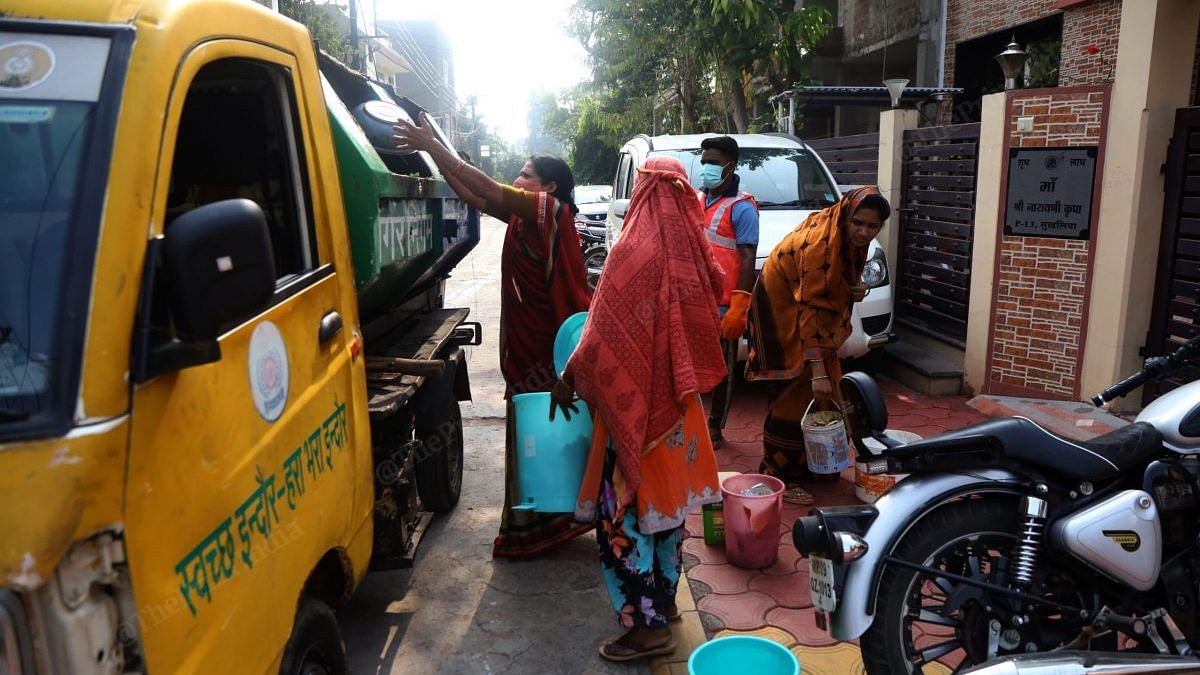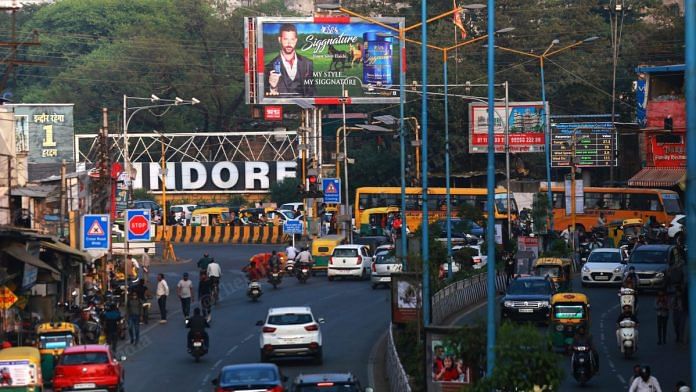Indore: A couple of months ago, some residents in Madhya Pradesh’s largest and most populated city, Indore, started a social media campaign against a woman who chucked a disposable Starbucks Coffee cup — the coffee chain puts customers’ names on their cups — on one of the city’s thoroughfares.
The idea was to get her to repent for littering. The campaign had the desired effect — a couple of days later, the woman turned up at the Starbucks outlet and apologised.
Indore, however, has form on this count — the city is abound with apocryphal tales of alert residents, hawkers, rickshaw and autorickshaw drivers ticking off people who are found throwing garbage in public places.
A senior Indore Municipal Corporation (IMC) official told ThePrint that, in one such incident, a safai mitra (municipal sweeper), armed with a broom, stopped an autorickshaw on a busy road after seeing a passenger throw out a plastic wrapper. The passenger was made to pick up the wrapper from the road.
According to Municipal Commissioner Pratibha Pal, it is this level of consciousness among residents and a high degree of public involvement that is behind Indore being continually adjudged the cleanest city in the country.
Last week, Indore retained the tag for the fifth consecutive year in the Swachh Survekshan (cleanliness survey) 2021 announced by the Modi government.
“People’s mindset has changed. They themselves come forward to flag or protest if they see garbage strewn around or someone littering in public,” said Pal, who took over as Indore’s municipal commissioner last May.
The benefits of this attitude are evident across the city — litter in public places is a rarity; so is spitting. There are no garbage dumps, while roads and footpaths are spotless. There are also no stray animals roaming around and hoardings are missing from the city’s walls.
All of this is bringing in other gains, apart from the overall quality of life improving.
“Property rates have increased. Investors are coming. There is all-round social, cultural and economic development of the city,” Pal said.
Manish Singh, Indore district collector who has also served as the city’s municipal commissioner, said pollution has reduced. “The quality of life has improved in Indore.
The 150 RSPM (Respirable Suspended Particulate Matter) level has come down to 70-80,” Singh said. “RSPM are particulate matter with diameter of less than 10 micrometers and are produced from vehicles, industrial sources, etc. Dust has reduced. We ensured that dust is not created. We have also expanded and improved the green belt.”
Indore could also be a lesson to other Indian cities that these standards can be achieved. For one, the turnaround came just seven years ago.
Before that, say residents, this commercial capital of MP, with a population of over 30 lakh people, was like any other Indian city.
“Garbage dumps were always overflowing. If somebody had told me back then that one day the city will look like what it is now, I wouldn’t have believed them,” said Nutan Samvatsar, 61, a retired teacher who lives near the busy Bapat Square.
But a combination of an incremental garbage reduction policy, insistence on waste segregation, and a change in mindset have all pushed Indore to achieve what seemed so impossible.
Also read: Swachh Bharat’s first transgender toilets in MP is a giant leap: IAS officer
How it all began
Indore’s journey towards becoming India’s cleanest city began early 2015, a couple of months after Prime Minister Narendra Modi launched the Swachh Bharat Mission to make the country clean and free of open defecation.
Manish Singh, then the city’s then municipal commissioner, took it as a challenge to get Indore on track.
When the central government in 2016 launched the Swachh Survekshan, the annual survey of cleanliness, hygiene and sanitation in cities and towns of the country, it provided the required momentum to the mission.
The first thing Singh decided to do was focus on strengthening the inhouse sanitation infrastructure.
“We built our fleet of door-to-door garbage collection vehicles. We strengthened the municipal workshop, where old vehicles go for repair,” Singh told ThePrint. “We beefed up our team of safai karamcharis and built their capacity.”
Today, the Indore Municipal Corporation (IMC) has a fleet of 1,500 vehicles and a team of 11,000 safai workers (some employed by a private contractor).
Once the team was in place, IMC deployed them for door-to-door collection of garbage. To encourage the city to comply with the civic body’s efforts, Pal said they just kept one goal a year.
“In 2015, we just talked about door-to-door collection. People were sceptical in the beginning. So, we took two wards on a pilot basis,” he said. “The results were very good. When people saw that municipal vehicles were coming daily to pick household garbage, it was easy to convince them to take the next step — segregating dry and wet waste.”
By the end of 2016, the IMC was carrying out 100 per cent door-to-door collection of garbage.
In the third year, the IMC focused on “reduce, reuse and recycle”, while the fourth year was about promoting home composting.
In the fifth year or 2019, the IMC told people to close any sewer connection opening into rivers or water bodies. “Our goal was that we won’t let our water bodies get dirty… We have cleaned the surface, this time, we will keep our water bodies clean,” said Pratibha Pal.
What went behind making Indore the cleanest Indian city
The most important link in this entire chain, according to Pal, was source segregation of garbage.
“There is a golden rule that the different ways we segregate our garbage, their value addition and capacity to recycle increases,” she said. “Indore started with two types of segregation, which today has increased to six types.”
A control-cum-command centre was set up to track the movement of garbage collection vehicles from the neighbourhood level to the processing centre.
Once the garbage is segregated, it is transported to the Garbage Transfer Station (GTS) for sorting. It is here that it is segregated into six types. The garbage is also compressed with machines and put in huge plastic capsules. The final destination of these capsules is the trenching ground where the Ahmedabad-based NEPRA Resource Limited has set up one of India’s biggest solid waste management plants.
Strict monitoring by municipal authorities coupled with strong action, which includes hefty penalties and suspension for dereliction of duty, has ensured that there are no gaps.
“Monitoring has become very stringent. There are six layers of line of control. And everyone’s target is to remain number one; so, we have to keep making the same effort and doing the same hard work every year,” said Ajit Kalyan, a chief sanitary inspector in IMC.

Heroes of the Indore cleanliness journey
Indore’s cleanliness journey has many heroes.
The first, invariably, are the Indoreans; the people of the city, who have changed attitudes to keep hold of their top rank.
“It’s a cultural shift that has happened. Residents now take it as their responsibility to keep the city clean,” Pal said.
The second set of heroes is the team of 11,000 safai mitras, the majority of whom are women.
Wearing sarees, holding brooms, some wearing gumboots and masks, they are a ubiquitous sight on Indore’s roads.
They are on the job from early morning until the dead of night. The safai mitras work in shifts — the first shift starts at 6.30 am, and the last one starts at 10 pm and ends at 7 am. The women in the night shift work in groups of 25 and have two male supervisors to oversee the work and ensure their safety.

Most of them have volunteered to work the night shift as they say it allows them to be with their family and children during the day. And they proudly tell you that they have played a role in Indore’s performance as the cleanest city.
“It makes us feel happy that Indore has come number one because of us too,” said Rekha Ratan, a safai mitra working in ward 33.
Pal said the third set of heroes are the political representatives who firmly stood behind and supported the administration in executing tough decisions.
“The fourth hero is the administration. Our journey stands on these four pillars,” she added.
A strong civil service leadership at the top ensured the entire cycle of garbage segregation, collection and processing is followed meticulously.
It is not just garbage segregation and processing.
A massive drive was undertaken to remove stray cattle loitering on the roads. Manish Signhal, the Indore district collector, who was the city’s municipal commissioner between 2015 and 2018, said some 40,000 stray cattle were removed from the roads. “Milching cattle were taken to panchayat areas and kept there,” he said.
Indore has a floating population of around 2.5 lakh who travel for work daily. The IMC built public toilets after every 200 m, which are well maintained. “People don’t have to think twice if the toilets will be clean,” Pal said.
A multi-pronged approach by the administration is what ensured all-round cleanliness in the city.
The IMC also engaged NGOs to use their soft skills to create awareness among people about different aspects of cleanliness and convince them about the importance of source segregation.
“The NGOs acted as a bridge between the IMC and the public. We realised that many times, we might lack soft skills to convince and motivate the people. Here, NGOs were given that responsibility for community triggering. That played a major role,” Singh said.
How Indore has managed to sustain tag
The main reason, according to Pal, for the sustainability of the Indore model is that there are no gaps.
“There is 100 per cent door-to-door collection. Whatever garbage is collected goes through the entire cycle of sorting and 100 per cent processing,” she said.
If segregation is not proper, municipal staff refuse to collect the garbage.
“The main reason for sustainability is the awareness among the public to segregate. If the quality of segregation is good, automatically garbage quality also improves and private players come in,” she said.
The system got established so well that the common man has got used to the process. Indore has also shown it does not cost a bomb to stay clean.
Of the Rs 5,000 crore annual budget of the IMC, around Rs 1,200 crore is allocated for sanitation. This includes salary and other miscellaneous expenditure.
“Our operation and maintenance cost increased by just 25 per cent,” Singh told ThePrint.
The Indore municipality has also shown that if the service delivery is good, people are not reluctant to pay.
IMC levies nominal user charges from residents for door-to-door garbage collection. The charges range from Rs 60 per house per month in slums to Rs 90 per house per month in middle-class localities to Rs 150 per house per month in posh areas.
The IMC earned approximately Rs 240 crore last financial year from user charges. “Our recovery through user charges was 86 per cent last year. There is no reluctance. Public is happy and there is a sense of pride,” Pal said.

A win-win deal
In India, the PPP (Public Private Partnership) model in the sanitation sector has not been very successful. Political interference and operational issues are believed to have resulted in many private players opting out.
But it seems to be working seamlessly in Indore.
The Ahmedabad-based NEPRA Resource Management has set up India’s biggest solid waste management facility on 4.5 acres of land at a cost of Rs 43 crore.
The company entered into a 14-year agreement with the IMC in 2018 for operating and maintaining the plant, where 400 metric tonnes of dry waste is processed every day.
It’s a win-win deal for both.
While Nepra pays royalty of approximately Rs 1.5 crore per year to IMC for supplying dry waste for processing, it earns approximately Rs 1.5 crore to Rs 1.6 crore every month by selling the recyclables after processing.
Virendra Mane, head, city operations (Indore), Nepra, said the company has broken even. “We chose Indore because of 100 per cent source segregation of garbage. People are segregating waste at source, which is not happening in any other city at the moment,” he said.
Mohan Pandey, CEO of International Waste Management, the India subsidiary of the Kuwait-based National Cleaning Company, has had a similar experience. The company took up the night sweeping contract from the IMC in 2016.
Pandey said they decided to take up the project in Indore because of the work culture and “lack of political interference”. “IMC is very supportive. They have appointed one point person, whom our people can contact in case of any problem,” he said.
Pandey, whose company works in other countries including the UAE, Qatar, Turkey, the US, and the Philippines, said there is no political interference here in Indore.
(Edited by Arun Prashanth)
Also read: Study finds Indian households with female children reduce practice of open defecation



